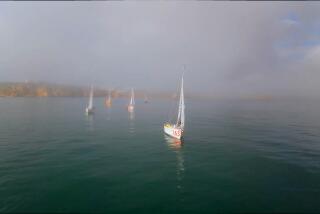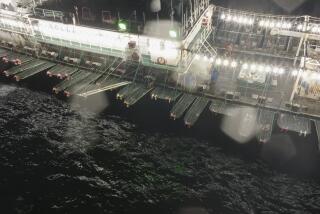Troubled Voyage : Amid Setbacks, Bounty’s Skipper Is True to His Dream
- Share via
LONG BEACH — “All men dream but not equally. There are those that dream at night, reaching into the dark recesses of their minds to wake in the morning to find it was vanity. But the truly courageous men are those that dream in the day with their eyes wide open for they can make their dreams come true.”
--T.E. Lawrence, Lawrence of Arabia.
In quoting the great Lawrence, Cmdr. Joseph McGuire, builder of ships, was telling the story of his daydream to build a truly splendid vessel that would sail the seas with the wind at its back and leave the 20th Century behind.
His own dream came true, said the silver-haired skipper, on a summer day in 1978, when a movie maker ordered construction of His Majesty’s Armed Vessel Bounty, just as it was 200 years ago when Capt. William Bligh was set adrift by his mutinous crew.
“In actual fact we live people’s dreams,” said McGuire, 62, as the sun shone through large gallery windows below the Bounty’s deck in Long Beach harbor. “They come down here and try and capture the romance of the days when graceful ships sailed the oceans.”
It is a romance with which McGuire seems permanently imbued.
For, even after 18 inglorious months in San Pedro Bay, after the Bounty’s armed seizure, its two-month detainment and a $1,000 fine by the Customs Service, after long months of waiting for a new assignment, McGuire said:
“We sit and wait and give a demonstration of perseverance and dedication to duty, and keep alive the romance of wind-driven ships.”
But as he spoke, it was clear that the circumstances of past months had taken a toll.
“I’ve become a little hardened,” he said. “We’ve been subjected to every indignity known to man by United States officials. I think it’s bureaucracy gone stark, raving mad.”
Then he hesitated. He wants no further trouble, he said. He just wants to sail his dream ship away from these hostile waters.
“I’ve got to be extremely careful when I speak about these things,” said McGuire, an Englishman who has been allowed to stay with his British-flag vessel. “But it’s a little difficult to accept. We’re not saboteurs or KGB agents. We’re just well-meaning people who were born 200 years too late.”
The Bounty remains in Long Beach as something of a floating museum, tucked away on a back channel to be discovered by those who patronize Sportfishing Landing on Pico Avenue in the northern port.
On weekends, passers-by are welcomed aboard at no charge to share with McGuire and his three deckhands the meticulous care with which their ship was recreated and is kept.
Some evenings, those who have befriended the Bounty are invited aboard to sing sea chanteys with McGuire and his crew.
Guests discover a ship whose exterior is a precise replica of the warship in which Bligh and Fletcher Christian sailed to Tahiti in 1787. The rigging, the Scottish flax sails, the Stockholm tar, the ship’s varnished wheel and the striking blue-dressed Englishwoman figurehead are all as they were back then. Every plank and railing has been crafted by hand.
Modern Accouterments
But below that 18th-Century deck are 20th-Century living quarters electronics. A satellite-assisted compass can pinpoint the ship’s location within 100 yards while at sea, and two 450-horsepower diesel engines can power it when ill winds blow.
Among the comforts of this modern yacht are reminders of the Bounty’s past.
In McGuire’s small cabin, for instance, copper sheathing and nails from the original Bounty are displayed. And at the foot of McGuire’s bunk bed is a large photograph of a painting of Bligh.
“When we get up each morning we say, ‘Good morning, Lt. William Bligh,’ ” said McGuire, using the selfless and royal we rather than the selfish and common I when referring to himself. (Bligh, whose rank in the Royal Navy was lieutenant, was the captain of the Bounty.)
“We feel that the spirit of Capt. Bligh is never far away,” said McGuire, who thinks Bligh was proven a great seaman by navigating 3,800 miles in an open boat after the mutineers set him and 18 others adrift.
But as McGuire recounted the history of Bligh, recalling the lost glories of the British Empire and reciting the poems of himself and others--modern commerce rattled and screeched from a nearby dock.
“We keep the ship very much alive in an environment that is hostile both politically and environmentally,” said the lean and natty former Royal Navy commander of engineers. “Each day we wash the ship down to remove the dirt that falls from the skies. We are most concerned with the sulfur, which is highly injurious to the sails.”
With each negative assertion, however, McGuire stops himself and retakes the high ground that makes his present situation less onerous.
“Good comes from everything,” he said. “I’ve heard (it) said that adventure is a set of adverse circumstances put to good use.”
The Bounty has been put to use here, he said, making friends of those who happen by and, on occasion, hosting short charity cruises--a junket for guests of the Port of Long Beach, a fund-raiser for the International Seafarer’s Center at the port.
But even such enterprises have spawned controversy. Two months ago, the Coast Guard stepped in to stop a second cruise for the Seafarer’s Center. McGuire could not charge for passage without a permit, even for charity, said the Coast Guard.
Now, neither the Bounty nor its crew accepts money for anything, McGuire said. “It is our earnest intention,” he said, “to sail this vessel away from Los Angeles.”
If, as McGuire expects, the Bounty departs next spring for Honolulu to become a tourist attraction or for Australia to prepare for that country’s bicentennial celebration in 1987, it will have been in local harbors for nearly two years.
In one rare moment of glory during that time, it was a star of the TOPSail ’84 tallship parade, which drew 1.5 million spectators. Photos of the Bounty were featured in Newsweek, Time and in other magazines and newspapers around the world.
After that July 4, 1984, spectacle, the Bounty set up shop at Shoreline Village, charging adults $1 and children 50 cents to board.
But the ship’s crew was already in trouble with Immigration and Naturalization Service officials.
McGuire and his original 22-man crew had arrived in late April, 1984, with 29-day visas to promote the opening of the Dino De Laurentiis film “The Bounty.” When McGuire called to extend the visas, as he insisted American officials in New Zealand said he could, immigration officials denied the request.
With just four days left on their visas, McGuire and six remaining crew members crossed into Mexico, got six-month tourist visas at the American consulate in Tijuana, and returned to Long Beach. The tactic was legal and the men were able to stay in the country.
Immigration, however, alerted the Customs Service to the Bounty’s presence. Paul Rimmer, then chief inspector for enforcement at the harbor, said recently that he ordered the ship seized in August, 1984, because he was convinced that the Bounty had violated three laws. It remained in custody at a commercial shipyard until Oct. 11, 1984.
McGuire and Bounty owners were charged with failing to register upon entry in the United States, engaging in illegal commerce and attempting to sell the ship without first posting the required duty.
“This wasn’t something we did lightly or offhandedly,” said Rimmer recently. The ship, which McGuire said was for sale for $4 million, could have been sold and in international waters within 20 minutes, and about $80,000 in duty due the United States might never have been paid, Rimmer said.
McGuire lashed out at Customs. He had obtained a city business license, and he had been told by customs officials in Honolulu that the Bounty was cleared for entry, the commander maintained. But he said that he had not noticed the small print on a document that required him to notify authorities when he arrived here.
After months of negotiation, two charges were dropped and the Bounty’s owners paid a $1,000 fine for failing to register the vessel, a misdemeanor that alone would not have allowed seizure of the ship, Customs Service attorney Robyn Bacon said.
Not long after the Bounty was seized, McGuire took a single red rose to the local customs house and laid it before a stern-faced woman, he said.
“This may appear to be a red rose,” he said he told her, “but it is actually an olive branch. Would you please stop hurting us?”
Harshness changed to courtesy after that, and though he and his ship are free to leave the country, he said: “I still have not made my peace with Mr. Paul Rimmer. He said I had knowingly and flagrantly broken the laws of the United States and was therefore guilty of gross negligence . . . . I cannot leave this country until he withdraws that statement.”
Rimmer said he still believes McGuire was “not as knowledgeable or as organized as he should have been to avoid problems with federal authorities.”
But he added: “Capt. McGuire is a person who was easy to like. . . . I felt he was basically honest and personable. He fit his ship. It was a unique ship, a replica of something that was a major part of commerce in a time past. Capt. McGuire seemed to match that.”
Others who know McGuire said that while he is a romantic, he can be as practical and logical as his decades of experience in ship-building would suggest.
“I think that despite the fact that he has the heart of a poet, he is also well aware of regulations,” said Elmar Baxter, a public information officer for the Port of Long Beach. “But he may not be quite as prepared for today’s bottom-line world as (are others).”
‘Bit of a Mystery’
Harbor officials remain convinced, said Baxter, that customs officials overreacted to the Bounty.
“Everybody here thinks it could have been handled by notifying him and (levying) a small fine,” said Baxter. “It’s a bit of a mystery why the Bounty was singled out for such scrutiny.”
McGuire is admired by many, said Baxter, because of his generosity to the port and his kindly nature. And because he has stuck with his ship.
“That ship is his life,” said Baxter. “He’s got a lot more staying power than most people, I’ll tell you.”
McGuire has returned to his wife and home in New Zealand only once since the Bounty set sail for America in early 1984. He expects to return again at Christmas.
It is his intent, he said, to stick with the Bounty as long as De Laurentiis continues to pay the $12,000 a month it takes to maintain the ship and pay the crew, or until it is sold for a non-seafaring enterprise. A De Laurentiis company leases the ship from a British firm, Bounty Expositions Ltd.
Several potential buyers have expressed interest in the Bounty at its current $2-million sales price, McGuire said.
“They’ve asked me if I would stay with the ship,” he said. “And I’ve said yes. But if you want to set it alongside (the dock) and sell candyfloss and T-shirts, get some bugger else. We want to sail.”
More to Read
Sign up for The Wild
We’ll help you find the best places to hike, bike and run, as well as the perfect silent spots for meditation and yoga.
You may occasionally receive promotional content from the Los Angeles Times.






